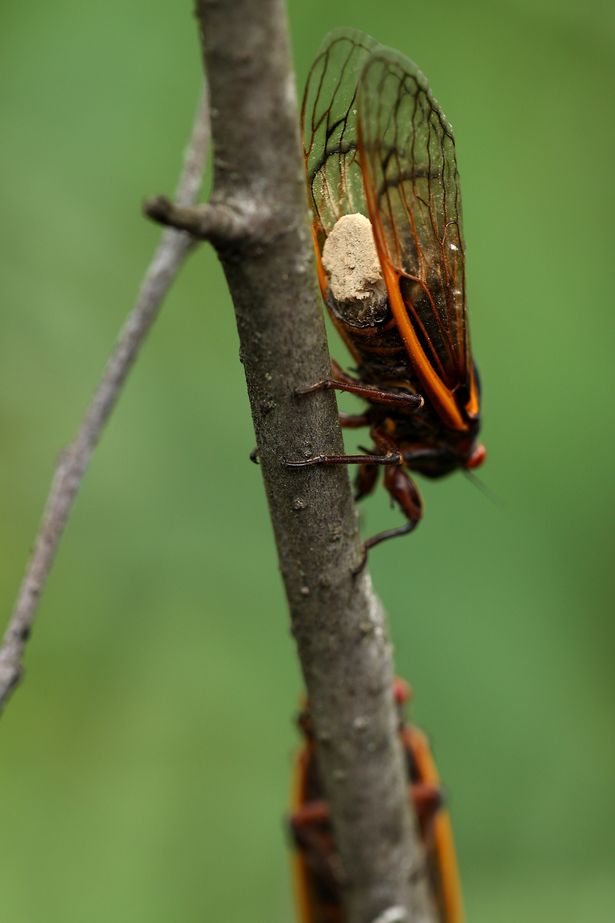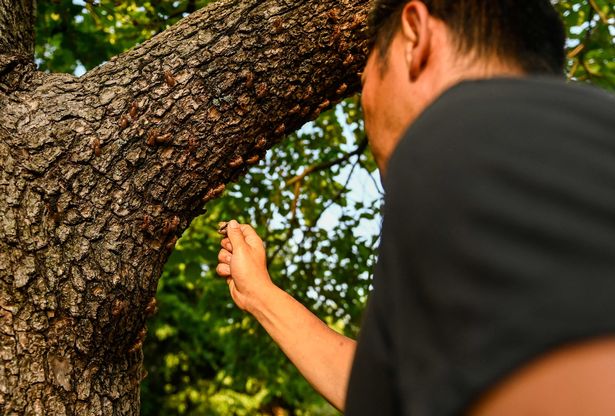After 17 years spent alone underground billions of red-eyed cicadas are now emerging in a stunning natural display.
Wooded areas up and down the US East Coast are breaking into a deafening buzz to mark the arrival of the vast horde of insects.
Their goal following the years spent underground is to find a partner, to breed and then to die.
On emerging, the insects blanket the trees and ground, with the males filling the air with buzzing and whistling to attract females.
But that sound also brings tourists and scientists to study this rare event.
With air temperatures and surface soils warming from climate change, scientists are also keen to learn how the creatures are responding.

(Image: Getty Images)
Temperatures affect when cicadas emerge and their underground growth. Scientists saw large numbers of 17-year cicadas surface years ahead of schedule in 2017, which entomologists suspect could be related to global warming.
“The biggest questions are: Is climate change changing their life cycles? And then, how does it change them?” said Chris Simon, an evolutionary biologist at the University of Connecticut who has studied the insects for more than three decades.
Along with her husband, Simon has spent most of May driving around the U.S. East Coast, chasing online reports of this year’s brood emerging in order to map out the precise range.
Her husband, oceanographer Stephen Chiswell, often partners with her during cicada trips and has published with her on the topic.
The 17-year cicadas emerging this year make up Brood X, one of the largest periodical cicada broods.
Other periodical cicada broods show up every 13 or 17 years in other regions of the country, and still other cicadas emerge annually.
Simon has coordinated with other scientists to map their full range and has kept to smaller, country roads where traffic will not drown out the cicadas’ sound, particularly that of the most common — and quieter — species, Magicicada Septendecim.

(Image: AFP via Getty Images)
“It’s kind of a lower pitch, more mellow, and you can’t really hear it when you’re on a highway,” Simon said.
The cicadas are the offspring of insects that emerged in 2004. After cicadas pair and mate, the female carves grooves into a tree, where she lays hundreds of rice-shaped eggs.
Soon after the eggs hatch, the larvae fall to the ground and burrow into the earth.
They dig out solitary chambers and begin growing as they feed on tree sap until it is time to re-emerge and repeat the cycle.
Some insects pop up four years too early or late. That has led Simon and other scientists to suspect the insects somehow track when four years have gone by — a mechanism that could be disrupted by climate change.

(Image: AFP via Getty Images)
In some areas in recent decades, early groups are getting bigger and surviving longer. The early Brood X cicadas in 2017 showed up in larger numbers than ever recorded.
“We think the big swings in climate contributed to the evolution of the seven species that we have now,” said John Lill, a cicada researcher and chair of George Washington University’s biology department.
There is clear evidence that cicadas were pushed south during the last glaciation event, he said, then expanded their ranges northward again as the Earth warmed.
But today’s rapid temperature shifts are “totally different” than the gradual climate shifts of the past, he added.


